Unsure about your French table manners? Click Here to download > > How to avoid these 10 food etiquette mistakes !
- Home ›
- Destinations ›
- Loire Valley ›
- Loire Valley by Train
The Easy Way to See the Loire Valley from Paris by Train
Published 11 August 2025 by Leyla Alyanak — Parisian by birth, Lyonnaise by adoption, historian by passion
Exploring the Loire Valley by train is entirely possible, with direct rail access to many of the region’s key castles and towns. This guide shows you where you can go without a car — and how to do it efficiently.
The Loire Valley is one of the most historically significant regions in France.
For a time, it was the seat of royal power, and the sheer number of castles here is unmatched anywhere else in the country. These châteaux weren’t just ornamental — they were part of political, military, and cultural life at critical moments in French history.
UNESCO has recognized a large stretch of the valley as a World Heritage Site not only for its castles, but for its cultural and historical legacy. This is the heart of France — the place where our history was often made.
NOTE: Pages on this site may contain affiliate links, which support this site. See full Privacy Policy here.
Everyone wants to visit the Loire Valley, and it can be frustrating without a car. But not impossible.
How to get the most out of the Loire Valley without a car
Quite a few Loire châteaux are reachable by train, sometimes with a short walk or local shuttle.
A few may require a taxi, but you won’t need to rent a car for every visit. Others are best left for another trip — this article focuses only on those you can see easily, even without driving.
Châteaux with direct train service can be visited year-round. Those that require a bus or shuttle often run only in the tourist season; outside those months, you may need to take a taxi. Always check current schedules before booking.
Amboise
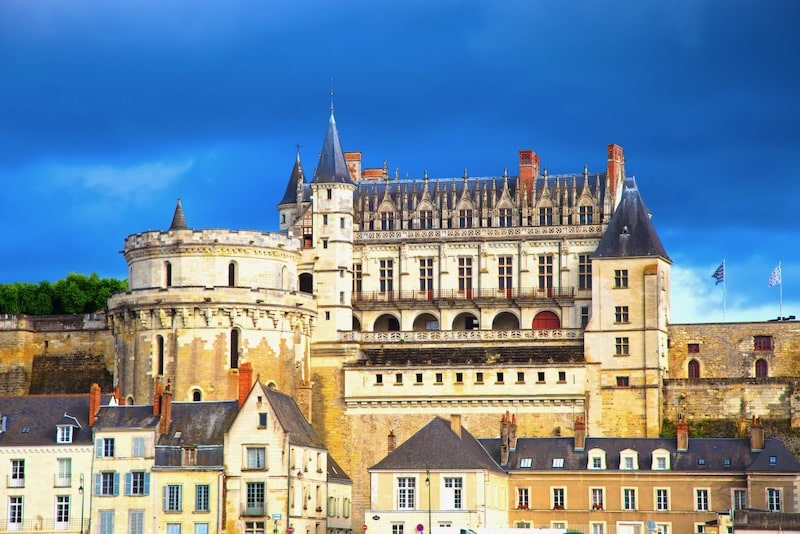
- Station name: Amboise
- From Paris: Gare d’Austerlitz
- Walk to the chateau: 20 minutes, 10 to reach the base of the château and another 10 uphill
The Château d’Amboise was a popular royal residence during the Renaissance and many royals grew up there, including François I, who spent part of his youth there..
It played a central role in court life and hosted figures such as Leonardo da Vinci, who spent his final years nearby. But it also witnessed darker moments, including public executions during the Amboise Conspiracy in 1560.
Look out for:
- Leonardo da Vinci’s tomb in the newly renovated Chapelle Saint-Hubert
- The spiral cavalier ramp built to allow horses up to the terraces – wide enough for a carriage
- The Renaissance loggia overlooking the Loire
- Subtle Italian detailing in the ceilings and fireplaces of the royal apartments
- The magnificent gardens at the back – and notice how utterly different this particular chateau is from the back or the front
🏰 🏰 🏰 🏰
Angers
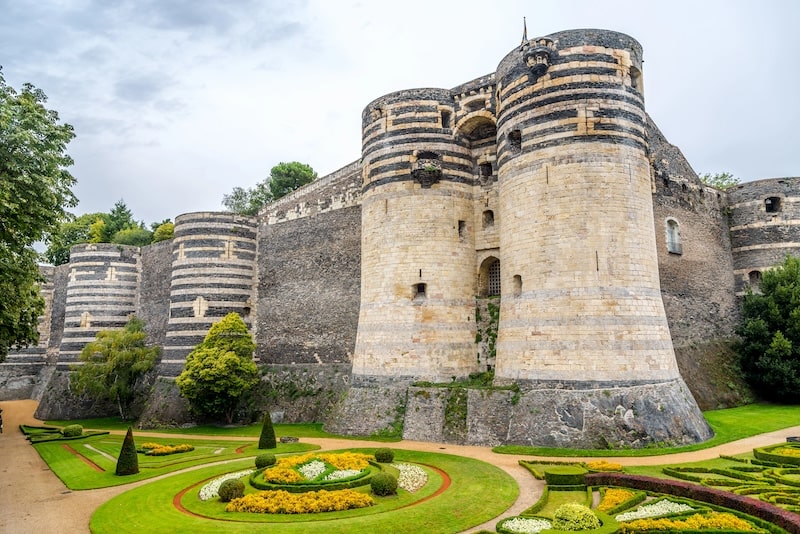
- Station name: Angers-Saint-Laud
- From Paris: Gare Montparnasse
- Walk to the chateau: 15 minutes
The Château d’Angers is a massive medieval fortress built in the 13th century by Saint Louis to protect the western gateway to the kingdom.
With its 17 defensive towers and thick ramparts, it was long considered impregnable.
Inside, it houses the extraordinary Apocalypse Tapestry, the oldest and largest surviving medieval tapestry cycle in the world.
Look out for:
- The 14th-century Apocalypse Tapestry (over 100m long)
- The contrast between grim military towers and manicured gardens
- The chapel of Saint Geneviève, with its Gothic ribbed vault
- Views over the Maine River from the battlements
- The original drawbridge and gatehouse, still intact
🏰 🏰 🏰 🏰
Azay-le-Rideau
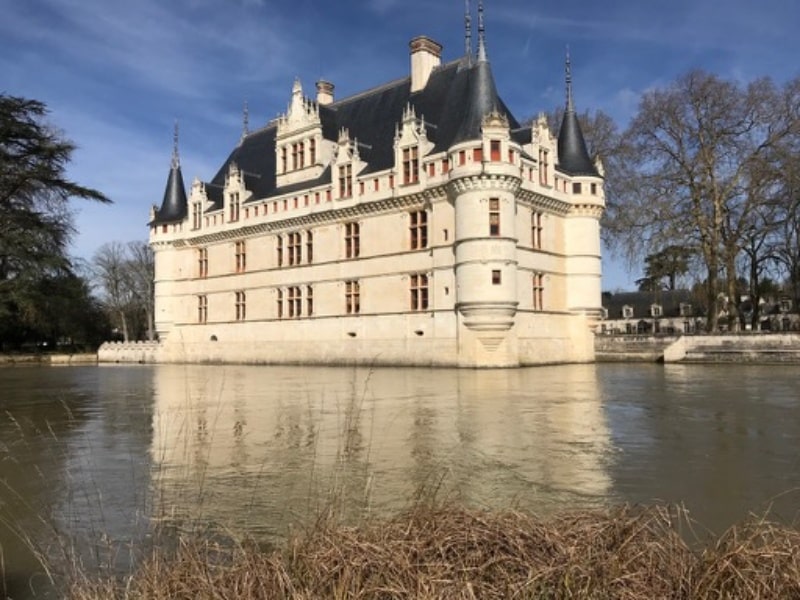
- Station name: Azay-le-Rideau
- From Paris: Gare Montparnasse
- Walk to the chateau: 25 minutes
Built on an island in the Indre River, the Château d’Azay-le-Rideau looks like it's floating. This jewel of early French Renaissance architecture was commissioned by a wealthy financier under François I.
It combines Italian influence with traditional French forms, and its perfectly symmetrical façades and reflection in the water have made it one of the most photographed castles in the Loire.
Look out for:
- The grand staircase with Italianate loggias on each landing
- The ornate coffered ceilings and carved salamanders (François I’s emblem)
- 16th-century tapestries depicting courtly and biblical scenes
- The sculpted dormer windows overlooking the moat
- The illusion-like reflection of the château in the river
🏰 🏰 🏰 🏰
Blois
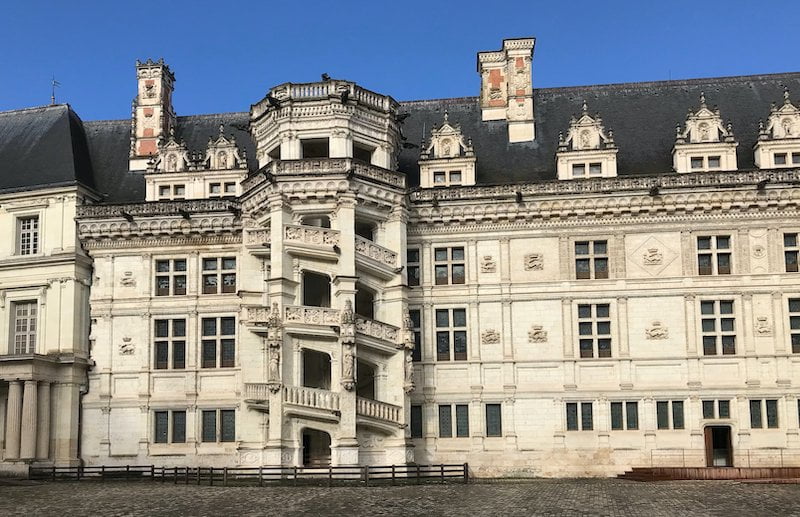
- Station name: Blois-Chambord
- From Paris: Gare d’Austerlitz
- Walk to the chateau: 10 minutes
The Château de Blois was the political heart of the French monarchy in the 16th century, home to seven kings and ten queens.
Its intriguing architecture spans four distinct styles — Gothic, Flamboyant, Renaissance, and Classical — one next to the other. It was here, in 1588, that King Henri III ordered the assassination of Henri de Guise, a turning point in the Wars of Religion.
Look out for:
- The spiral staircase of the François I wing, open to the courtyard
- Catherine de Medici’s study, with secret cabinets set into the paneling
- The ornate fireplace in the Salle des États, once the seat of royal assemblies
- The murder chamber where the Duc de Guise was killed
- The richly colored façade of the Louis XII wing, with its equestrian statue
🏰 🏰 🏰 🏰
Chambord
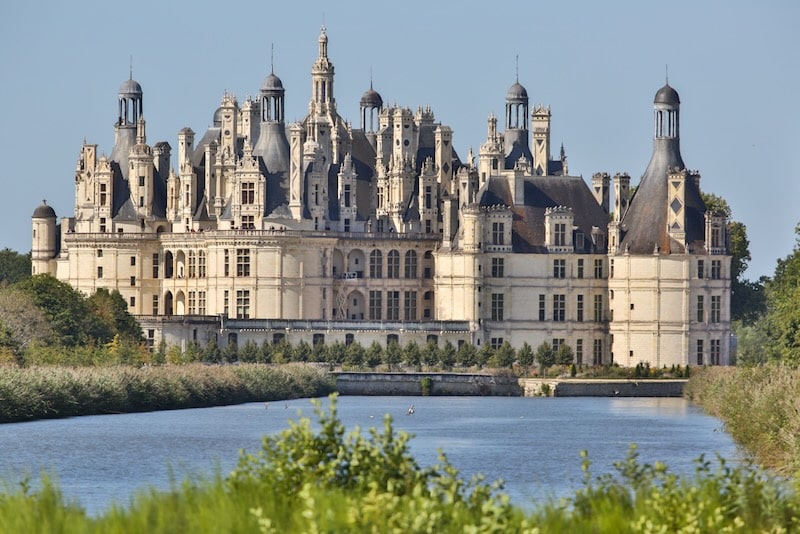
- Station name: Blois-Chambord
- From Paris: Gare d’Austerlitz
- Access to the chateau: Shuttle bus from Blois station, approx. 35 minutes (Navette Rémi, in season only — check times in advance)
Chambord is one of the largest and most ambitious castles in France, set within Europe’s biggest enclosed forest park.
Built from 1519 at the request of François I, Chambord was intended as a grand hunting lodge. But above all, it served as a display of royal power and architectural innovation.
The architecture is a mix of medieval forms and Renaissance symmetry.
Look out for:
- The double-helix staircase, said to have been inspired by Leonardo da Vinci
- Rooftop terraces with sculpted chimneys and open views over the estate
- The sheer scale: 426 rooms, 77 staircases, 282 fireplaces
- The formal French gardens and canal, restored to 18th-century designs
🏰 🏰 🏰 🏰
CATCHING A TAXI FROM THE TRAIN STATION
Don’t assume you’ll find taxis waiting at smaller train stations. Most don’t have a taxi stand, and drivers often work only with reservations. This applies even in fairly well-known places like Azay-le-Rideau, Chinon and Langeais.
If you plan to take a taxi from the station, book it in advance (at least the day before), or ask your accommodation to arrange one for you. Tourist offices sometimes have taxi lists, but these may not be reliable on short notice. Apps like Uber rarely work outside major cities.
Just Search [name of town] + taxi. If the phone number starts by 06, you can send a text from your phone (and use Google Translate if you don't speak French).
🏰 🏰 🏰 🏰
Chaumont-sur-Loire
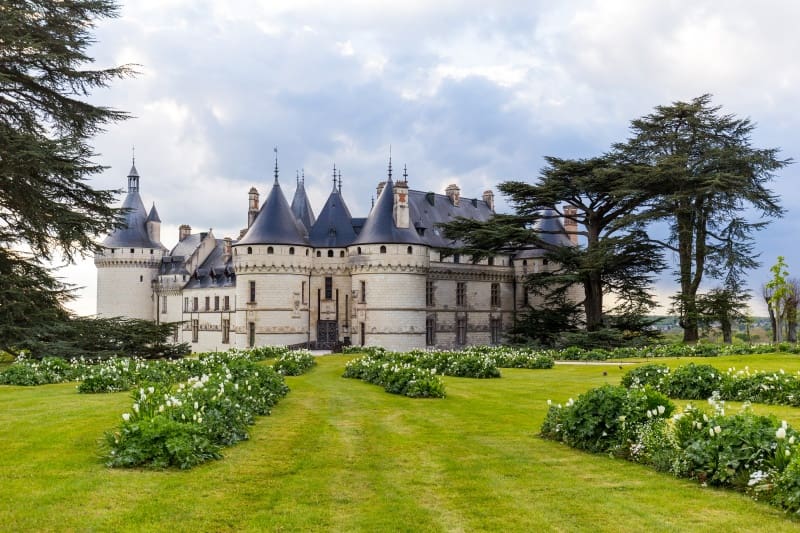
- Station name: Onzain-Chaumont-sur-Loire
- From Paris: Gare d’Austerlitz or Montparnasse
- Walk to the chateau: 35 minutes across the Loire and uphill (or take the seasonal shuttle, 5 minutes)
Originally a medieval fortress, Chaumont-sur-Loire was rebuilt in the 15th century and later transformed into a refined residence.
It once belonged to Catherine de Medici, who forced Diane de Poitiers to exchange it for Chenonceau after Henri II’s death.
Today, the château is also home to an internationally recognized garden festival held annually from April to November, and walk around the grounds and you'll bump into artworks everywhere. A wonderful experience!
Look out for:
- Catherine de Medici’s tower apartments and oratory
- The preserved stables, among the most luxurious of the 19th century
- Art installations throughout the château and grounds
- The Festival International des Jardins, with new contemporary designs each year
🏰 🏰 🏰 🏰
Chenonceau
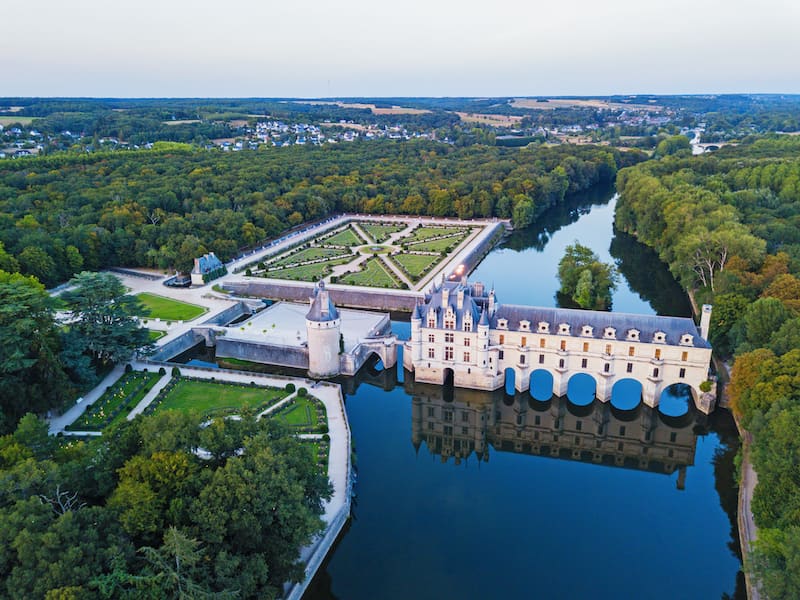
- Station name: Chenonceaux
- From Paris: Gare d’Austerlitz
- Walk to the chateau: 2 minutes from the station
Spanning the River Cher in a series of elegant arches, the Château de Chenonceau is one of the most distinctive and best-loved castles in France.
Known as the “Château des Dames,” or the Ladies' Castle, it was shaped and expanded over time by a series of influential women — including Diane de Poitiers and Catherine de Medici — who left their mark on its architecture and history.
Diane de Poitiers was given the château by Henri II; Catherine de Medici forced her to exchange it for Chaumont after the king’s death.
It is unique, and an absolute highlight of the Loire Valley.
Look out for:
- The gallery stretching across the river, added by Catherine de Medici
- Diane de Poitiers’ formal gardens on one side, Catherine’s on the other
- The 16th-century kitchens, located in the bridge piers
- Lavishly furnished rooms with original tapestries and portraits
- The small but poignant chapel with stained glass windows restored after WWII
🏰 🏰 🏰 🏰
Cheverny
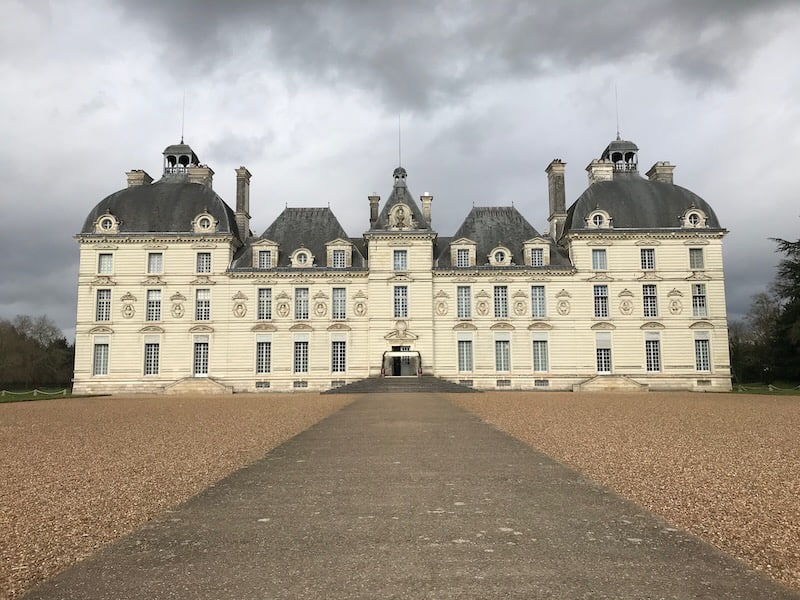
- Station name: Blois-Chambord plus shuttle transfer
- From Paris: Gare d’Austerlitz to Blois, with a shuttle between April-Nov
- Walk to the chateau: Only by direct shuttle in season
Cheverny Castle may look familiar if you've ever read the Tintin comics by Hergé... it is said that the author used it as his inspiration for Captain Haddock’s ancestral home: Marlinspike Hall (Château de Moulinsart).
Built in the 17th century, it is still privately owned by the same family. Its lavish interiors, rich with tapestries, paintings, and period furniture, show off centuries of aristocratic life.
The exterior is as interesting as the interior, with massive thematic decorations varying with each season.
- The grand staircase and fully furnished salons, rare for Loire castles
- 17th-century Gobelins tapestries and family portraits
- Expansive French formal gardens and a hundred-hectare park
- The kennels, still home to a giant pack of hunting hounds
- The permanent Tintin exhibition in the dedicated pavilion
🏰 🏰 🏰 🏰
Chinon
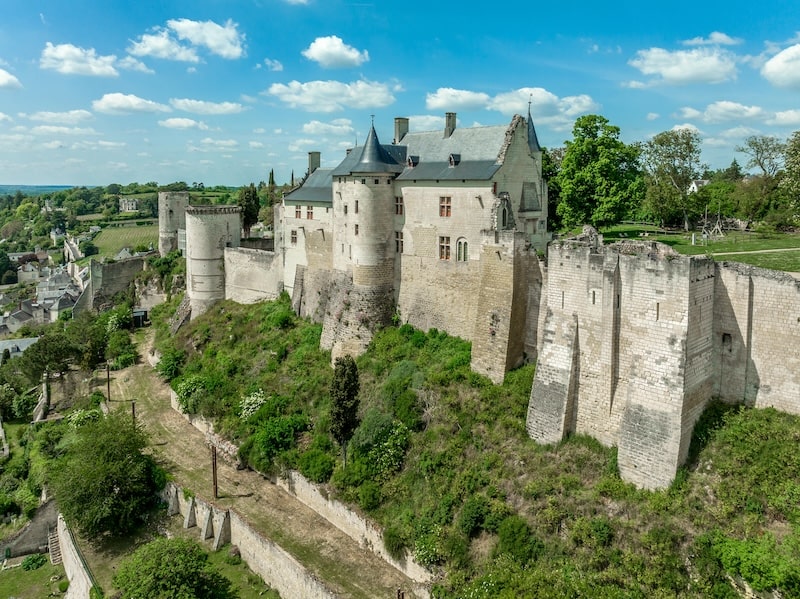
- Station name: Chinon
- From Paris: Gare Montparnasse
- Walk to the chateau: 30 minutes uphill from the station through the old town
Standing proudly above the Vienne River, the royal fortress of Chinon played a key role in the power struggles between the French and English crowns.
It hosted major historical figures including Eleanor of Aquitaine, Henry II of England, and their son King John, and the head of the Templars was for a time imprisoned here.
In 1429, it became the setting for one of the most famous moments in French history — the first meeting between Joan of Arc and Charles VII.
Look out for:
- The medieval towers and fortified walls with sweeping views of the valley
- A room associated with Joan of Arc’s first meeting with Charles VII (reconstructed; one original wall remains)
- The archaeological gallery tracing the site's 1,000-year history
- The 3D reconstructions and multimedia displays throughout the grounds
- The ramparts walk with panoramic views over the old town and river
🏰 🏰 🏰 🏰
Clos Lucé

- Station name: Amboise
- From Paris: Gare d’Austerlitz
- Walk to the chateau: 30 minutes from the station, 10 minutes from the Château d’Amboise
More a manor than a chateau, the Clos Lucé – a few minutes' walk from the Château d’Amboise – was Leonardo da Vinci’s final residence.
Invited to France by François I in 1516, he spent his last three years here, working, designing, and reflecting. Today, the manor is dedicated to his life and inventions, with preserved rooms and an interactive park with full-scale models of his machines.
You can touch them and climb over the inventions to see how they really work!
Look out for:
- Leonardo’s bedroom and studio, furnished as they would have been (he is buried at Amboise Castle)
- A passage is said to have once linked Clos Lucé to Château d’Amboise, but no trace remains today
- Scale models of da Vinci's inventions, including a tank, paddle boat and flying machine
- The Renaissance gardens inspired by his notebooks
- Temporary exhibitions on art, anatomy,and engineering
🏰 🏰 🏰 🏰
Langeais
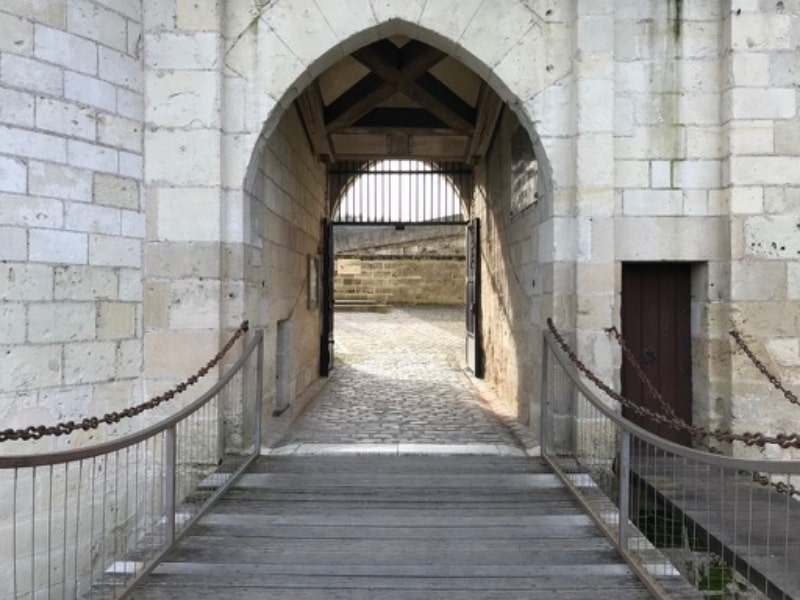
Station name: Langeais
From Paris: Gare Montparnasse
Walk to the chateau: 10 minutes from the station
The drawbridge of the Château de Langeais actually still works – there can't be many like this.
If that's not enough, this castle is the site of one of the most significant moments in French history: the secret 1491 marriage of Charles VIII and Anne of Brittany, which brought Brittany into France.
Look out for:
- The working drawbridge and defensive walkway with machicolations
- The re-created wedding scene of Anne and Charles VIII
- Interiors furnished with 15th-century-style tapestries and furniture
- The 10th-century stone keep, among the oldest in France
- The contrast between fortress exterior and Renaissance courtyard façade
🏰 🏰 🏰 🏰
Loches
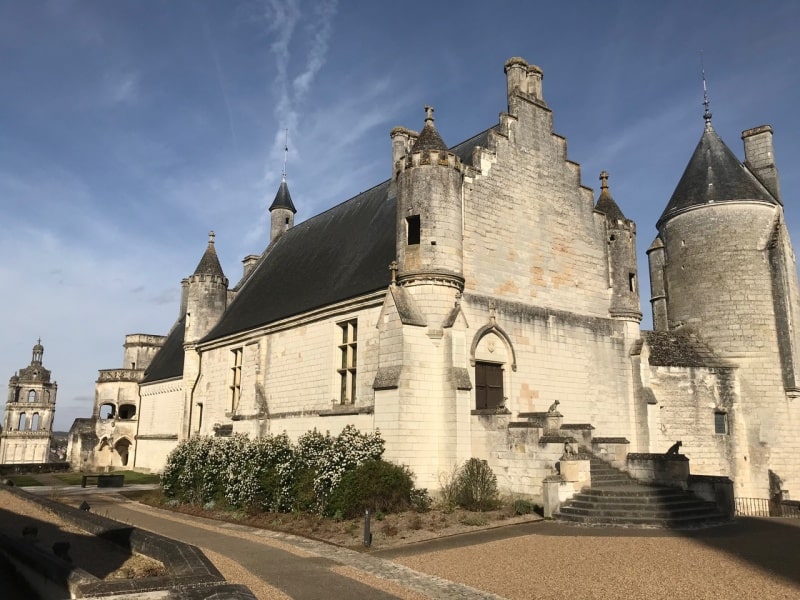
- Station name: Chateau de Loches
- From Paris: Gare Montparnasse
- Walk to the chateau: 15 minutes uphill from the station
The Cité Royale de Loches isn't just a castle – it's an entire complex that includes an 11th-century dungeon, making it one of the most striking fortified sites in the region.
The fortress served both military and political functions, and spans five centuries of history. It played host to Joan of Arc, Anne of Brittany, and royal mistress Agnès Sorel.
Look out for:
- The 37-meter-tall Romanesque keep, among the best preserved in Europe
- The royal apartments where Joan of Arc stayed after Charles VII's coronation
- The tomb of Agnès Sorel, the first official royal mistress
- Stark prison cells and graffiti carved by historical inmates
🏰 🏰 🏰 🏰
Saumur

- Station name: Saumur
- From Paris: Gare Montparnasse
- Walk to the chateau: 25 minutes, crossing the Loire and climbing to the château
Saumur began as a medieval fortress and was transformed into a princely residence in the 14th century. Its turrets and pale stone might just remind you of a fairy-tale, but its history is complex, ranging from military stronghold to prison.
Today, it houses the municipal museum and offers panoramic views over the Loire and the Thouet rivers.
Look out for:
- The twin towers of the 14th-century keep
- Views over the Loire from the terrace and ramparts
- Museum collections: decorative arts, ceramics, and equestrian displays
- Remnants of its time as a prison under Napoleon
- The elegant Renaissance additions contrasting with medieval foundations
🏰 🏰 🏰 🏰
Valençay

- Station name: Valençay
- From Paris: Gare Austerlitz or Montparnasse (check)
- Walk to the chateau: 10 minutes from the station
The Château de Valençay is quite eclectic, Renaissance and classical design with 18th-century additions.
Best known as the residence of Charles-Maurice de Talleyrand, Napoleon’s influential diplomat, the château was designed to impress foreign dignitaries. Its interiors are exceptionally preserved, with original furnishings, formal rooms, and a striking diplomatic collection.
Look out for:
- Lavishly furnished salons with period décor
- The circular medieval keep, still integrated into the structure
- Talleyrand’s library, office, and private apartments
- A collection of diplomatic gifts and ceremonial objects
- The 53-hectare landscaped park with formal gardens and woodland paths
🏰 🏰 🏰 🏰
Villandry
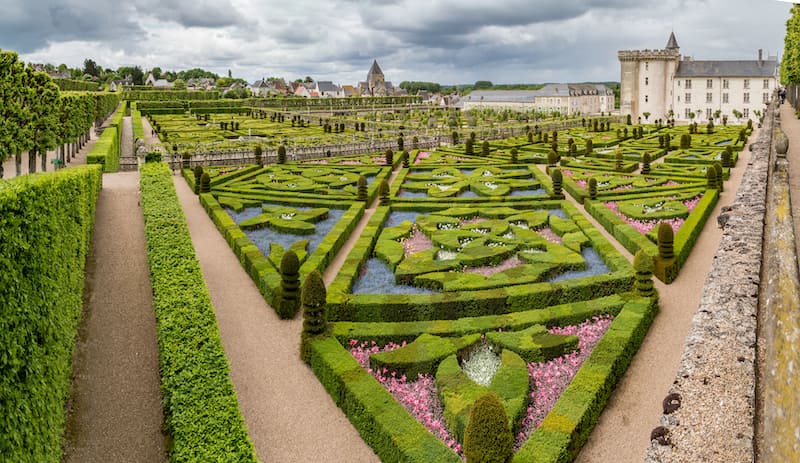
- Station name: Tours (+ bus)
- From Paris: Gare Montparnasse, and then bus #35
- Walk to the chateau: 5 minutes from the shuttle stop
The last of the major Loire châteaux to be built during the Renaissance, Villandry incorporates the remains of a medieval fortress — its original keep still stands.
While the château itself is elegant and well proportioned, it’s the gardens we come here for. Laid out in six distinct sections, they are among the finest examples of formal French landscaping in the country.
Look out for:
- The panoramic viewpoint over the entire garden complex
- The stunning gardens – the ornamental kitchen garden with geometric vegetable beds; the garden of love, divided into four symbolic parterres; the water garden with its reflecting pool
- The medieval keep integrated into the Renaissance château
Before you go...
So you see, there are easy ways to see the Loire Valley from Paris by train, especially some of its most iconic castles.
If you're really short on time and just have one day, you can still see some Loire chateaux – several in fact. You'll find everything you need to know on my day trips to the Loire from Paris.
Need your hands free to take pictures of all these wonderful French sights? I use one of these wonderful infinity scarves to store my car keys, ID and cards – no bag to carry, no backpack to hoist. Get one here.
Did you enjoy this article? I'd love if you shared it!


